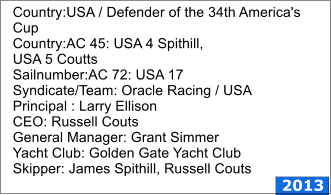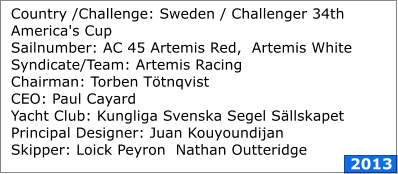




The basic principle of that powerful multi-hull
is similar to the AC45 catamaran. But the size
requires far higher technical requirements.
The parameters are as in all previous classes
set by a rule
In the drafting of Rule 72 was the design and
engineering office Morelli and Melvin involved.
This company had a lot of experience in
building catamarans. Among others they have
been involved in the design of D.Conner's HS-3
catamaran and the pitch bow of Oracles
BOR90.(2010).
It is a "box rule" with narrow technical limits
but gives still each team the opportunity for
some changes at the hulls, the wing, the head
sails, the L-shaped underwater foils, the
rudders and the dragger-boards.
During the first training phase 30 sailing days
within the time from
from 1 July 2012 up to 01.31.2013 have been
authorized.
The planned wing was originally 107 ft. = 33 m
high (the mast in the IACC class is 32.5 m
long). There were some considerations to
introduce in the AC72 class a removable sail
extension, too. But decided then to a 40 m
long wing.
The catamaran is steered by wheels, placed
either on each hull or a platform
amidships.(s.Oracle)

Due to the short time interval of 3 years and the high technical and financial costs, only 4 teams will
participate with AC72s in the Louis Vuitton resp. America's Cup.
Oracle Racing (USA) – as the defender and the challengers Emirates Team NZ (NZL), Artemis Racing
(SWE) and Luna Rossa (ITA). Team Koreas challenge is questionable.

Oracle Racing
Defender of the 34th America's Cup
The team was founded in 2000 and has brought back
he America's Cup to the USA after its 2:0 victory over
Alinghi 5.
Since this Cup was held with multi-hulls, it was
obvious that 2013 could be sailed with catamarans.
Through the trimaran BOR 90 Oracle has a know how
advantage and is the favourite.
In August 2012 the first AC 72 was christened. A 2nd
Yacht has been built later on
In October 2012 their first boat USA-17f lipped over in
a training in the San Francisco Bay when both bows
dipped under a front wave. The catamaran was
destroyed and its parts spread and collected over the
whole Bay.
The catamaran has been repaired, a spare wing was
ordered to New Zealand and delivered in early
January in San Diego.
By the loss of this boat Oracle got a considerable
training residue until the 2nd boat is ready.
Oracle Racing Team USA (ORTU)
Defender of the 34th America's Cup






The repaired catamaran # 17 is back on the water in February 2013 . The 40m high
wing requires a powerful crane boom.







Der
At 40 knots (72 km/h) the
crew will be less relaxed.
The catamaran after the rollover. The moveable flaps on
the wings are broken off and were washed away by the
flow from the Bay of San Francisco.
The first AC72 catamaran has set its two
headsails.
The AC72 is properly trimmed, further sailing
manoeuvres not provided.
The crew can train to optimize the speed
The first catamaran before the accident

Emirates Team New Zealand Challenger for the 34th America’s Cup
After the crash of the team in the AC 2000 and a
victory in the LVC 2003 New Zealand's team under
Grant Dalton, Dean Barker and the financial support
of Emirates Airlines is again a strong team that is the
favorite among the challengers.
The New Zealanders also helps the sophisticated
yacht- and its supply-industry. Oracle itself orders his
wings at Core Builders in Warkworth.
Videos show that the Kiwis are not afraid of hard
trainings in extremely strong winds.
In safety training the crew is learning safe jumps
from a great height. The crew members also carry a
small pressurized air bottle and a knife. For the case
they should be pressed in a rollover by the
trampoline net under the water.
Analysis of the photos from Oracle capsized AC72
catamaran show that crew members were hanging in
about 14 m height on the trampoline.
For the AC World Series the team sail an AC45
For the LVC and the AC a second AC72 is under
construction.
Emirates Team New Zealand
(Last used information from january 2013)
The New Zealanders also helps the sophisticated
yacht- and its supply-industry.









Good to see are the steering wheels, the "coffee-
grinder" with the coupled winches and several
crew members on the safety net, the trampoline.
The bent dragger-board with the L-shaped
foil is on the windward side pulled up, on
the leeward side lowered about halfway.
All photographs show the NZL-5, the second AC72
catamaran of ETNZ
The wing carries on the top already
the Loius Vuiiton Cup logo

Artemis Racing Challenger of Record 34th America’s Cup
Artemis Racing Challenger of Record
Among the ancient Greeks the bow armed Artemis
(who was imported later by the Romans as Diana) was
the goddess of the hunt, but also the patroness of
women and children.
Artemis Racing is a Swedish sailing team that has
made a good name on famous regattas, such as the
Extreme Sailing Series, the RC44 Championship or the
Vulcain Trophy Tour
Paul Cayard is an AC veteran, who won as helmsman
under Dennis Conner the 1995 Citizen Cup and who
reached 2000 with his own team in Auckland the LVC
finals.
After Mascalzone Latino had cancelled his challenge
because of financing difficulties and hence the
Challenger of Record,
On the technical side the team still faces initial
difficulties. During a towing test with the hull they
feared some structural weaknesses. The wing broke
during training.
A 2nd wing had been delivered..
On May 9, 2013, the ARTEMIS Racing AC72 overturned
and capsized at moderate weather,The catamaran broke
into many components. The Briton and two-time Olympic
gold medal winner Andrew "Bart" Simpson was killed
Artemis Racing is a Swedish sailing team that has made a
good name on famous regattas, such as the Extreme Sailing
Series,





© ACEA RBYACFEVD3_2587
© ACEA RBYACFEVD3_2723
© Sander van der Borch /Artemis Racing Launch
© ACEA RBYACFEVD3_2991

In Memoriam
Andrew “Bart” Simpson

The team will be sponsored by PRADA respectively its
owner. Patrizioio Bertrelli
Luna Rossa Challenge has registered as the last
challenger for the LVC 2013 and was so pressed for
time. Therefore it has signed with Emirates Team NZ a
so-called "strategic alliance". First they bought from
New Zealanders for an undisclosed sum, the design of
a wing together with its complex platform, but
constructed itself its own wing and the head-sails.
The hull was built in Italy, the rest in New Zealand.
Luna Rossa trained in Auckland and moved in March
2013 to San Francisco.
The alliance between the two teams moved in a gray
area and was suspiciously watched by the two other
teams.
In the AC 45 World Series Luna Rossa has run two
catamarans, the Piranha and the Swordfish. The
construction of a second AC72 was questionable and
at the end abandoned.
The hulls and parts of the wing are metallized and
give the catamaran a mirror like appear.
Luna Rossa Challenge 2013 Challenger for the 34th
America's Cup




© ACEA First Sailing day in the Hauraki Gulf
© ACEA U3C1171
© ACEA PRADA LAUNCH-233
The extendible boom of the jacked-up car-crane has an
estimated length of 55-60 m.

Emirates Team New Zealand "foiling" with both hulls out of the water. The windward side "draggerboard" is raised.
."Foiling" (sliding) comes from the term "Hydrofoiling". That means the
AC72 lifts at greater speed and winds of about 10 knots and especially
downwind, completely out of the water and sails on sliding surfaces (the
"foils" = hydrofoils) at the rudders and the draggerboards.
Each of the 2 draggerboards carries an inward, L-or J-shaped (Artemis I)
wing.
At the bottoms of the rudders are the T-shaped "elevators", a rigid,
symmetrical or asymmetrical, elliptical wing. (As "elevators" they lift the
boat out of the water, but can -just as the rudder itself -be moved only
horizontally).
In thousands - as says the team - processing and test hours ETNZ
developed the "foiling" The first tests on the water took place in
September 2012.
This technique has been successfully adapted by Oracle, Luna Rossa and
Artemis.
With this technique, the boats reached until now unimaginable speeds.
The New Zealanders sailed on the 18.July 2013 with 44.3 knots to the 80
km/h mark.
The "foils" were not specified in the AC72 Class Rule, since they were
developed after its entry into force

Broken rudderblade of Oracle with
the elevator

Foiling
The AC72 Class Rule and the 2 controversial points of the
37 points Safety Recommendations
Artemis II with the L-shaped "draggerboard" and the "elevator" on
the rudder blade’s end
The AC72 Class Rule is a set of technical
rules that determines the design
parameters of the AC72 catamaran in a
relatively wide range. The latest version
was Published on 16 July 2012.
When she came into force, the hydro-
dynamically highly developed retractable
draggerboards and the rudders were still
"flat boards" only - with the functions to
counteract the drift, or to steer the
catamaran and to keep it stable.
This AC72 Class Rule can be only
changed by the Measurement
Committee, with the approval of all
teams.
.
After the fatal accident of the Artemis
Racing catamaran on 9 in May 2013
Ian Murray, Regatta Director of the AC,
organized a Safety Committe. Then he
published Safety Recommendations with
2 key points.

•
1 point dealt with minimum sizes and shapeof the rudders and
rudder elevators.
•
The 2nd Punt provided for an increase in weight by 100 kg to 6000 kg.
After their analysis of the accident and after consultation with the teams and the Coast Guard on he issued 22
May, a comprehensive 37 point paper, the "Safety Recommendations.
These were binding proposals to optimize the safety on board and around for the followingl Cup events.
Iain Murray wanted to avoid in future that an AC72 can immerse with a bow and roll over due to too short
rudder blades or inappropriate elevator surfaces. He generated heated debates and protests
These proposals were interpreted as interference with the "AC72 Class Rule." For these changes the Regatta
Director was overstepping his competence. Responsible is the Measurement Committe with the required
approval of all teams.
While all the participants had accepted these points already before, ETNZ and Luna Rossa had raised on these
2 points an appeal to the "International Jury" and got right.
But as it was a formal decision only that the Measurement Committe is responsible, everything remained the
same.
Iain Murray with his 46 years of experience as a skipper, organizer and designer, a respected and integrity Cup
veteran, was suddenly -- to his great annoyance - also alleged to have written these two points on pressure of
Oracle
1982 they spoke of the attempts to throw Australia II because its wing keel from the Cup, of a "Keelgate"
(following President Nixon's Watergate). So now some journalists tried to speak of a "Ruddergate".





The first 4 AC72 catamarans







AMERICA’S CUP HISTORY 1983 - 2013









